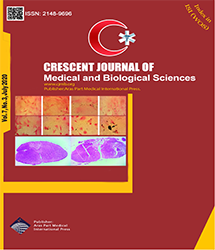
| Original Article | |
| Effects of Forearm Myofascial Trigger Point Dry Needling on Pain and Function of Patients With Carpal Tunnel Syndrome | |
| Vahideh Toopchizadeh1, Shima Karimnia1, Bina Eftekhar Sadat1, Fatemeh Jahanjoo2, Mohammad Zakaria Pezeshki3 | |
| 1Physical Medicine and Rehabilitation Research Center, Aging Research Institute, Tabriz University of Medical Sciences, Tabriz, Iran 2Road Traffic Injury Research Center, Tabriz University of Medical Sciences, Tabriz, Iran 3Department of Community and Family Medicine, Tabriz University of Medical Sciences, Tabriz, Iran |
|
|
CJMB 2020; 7: 362-367 Viewed : 7084 times Downloaded : 5019 times. Keywords : Carpal tunnel syndrome, Forearm muscles, Dry needling, Trigger point |
|
| Full Text(PDF) | Related Articles | |
| Abstract | |
Objectives: To evaluate the effects of dry needling (DN) on pain and function in patients with concurrent carpal tunnel syndrome (CTS) and forearm muscles myofascial trigger point (MTrP). Materials and Methods: This randomized controlled trial evaluated fifty affected hands with the clinical and electrodiagnostic diagnosis of mild and moderate CTS with the presence of MTrP in their forearm muscles. Patients were randomized to intervention and control groups. In the intervention group, one session forearm MTrP DN was performed in addition to wrist splint. Then, pain and function were assessed using the visual analogue scale (VAS) and Boston Carpal Tunnel Questionnaire (BCTQ) at the baseline, one week, and six weeks after the intervention in both groups. The outcomes in this study were pain reduction (VAS) and improvement in hand function (BCTQ). Results: The co-occurrence of mild and moderate CTS with forearm muscle MTrP was observed in 61% of cases. In addition, improvement in pain severity, VAS, a mean difference of 1.44 (with a 95% CI of 0.96, 1.92, P < 0.001), the BCTQ total score, and a mean difference of 0.21 (with a 95% CI of 0.10, 0.32, P < 0.001) were observed in the DN group compared with the control group at one-week follow-up. Conclusions: In general, forearm MTrP should be considered when examining patients with CTS since MTrP therapy in patients with CTS can enhance the effectiveness of physical therapy on symptom improvement in short terms. |
Cite By, Google Scholar
Google Scholar
PubMed
Online Submission System
 CJMB ENDNOTE ® Style
CJMB ENDNOTE ® Style
 Tutorials
Tutorials
 Publication Charge
Medical and Biological Research Center
About Journal
Publication Charge
Medical and Biological Research Center
About Journal
Aras Part Medical International Press Editor-in-Chief
Arash Khaki
Deputy Editor
Zafer Akan


















